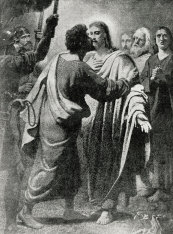15 Unusual Ways Crimes Have Been Solved
 The techniques used to solve crimes have come a long way since ancient times
and even in the past century and a half. We may never know who actually murdered
Andrew Jackson and Abby Durfee Borden, but if these crimes occurred now with all
of the scientific advancements in forensic science most likely the killers would
be found, tried, and convicted. Anything from blood spatter to carpet fibers and
even the slightest trace of cells containing the perpetrator’s DNA can give a
criminal away and give the prosecution a conviction. Throughout
criminological history the practices and methods used by investigators have
varied and been modified based on the changing needs of criminal investigators,
and the rapidly varying technologies available to investigators during the 21st
century. With all of the advances in forensic science, district attorney
offices around the world have powerful tools at their disposal that make
convicting a perpetrator easier as well as minimizing the chances of convicting
an innocent person by offering methods to exclude suspects. The techniques used to solve crimes have come a long way since ancient times
and even in the past century and a half. We may never know who actually murdered
Andrew Jackson and Abby Durfee Borden, but if these crimes occurred now with all
of the scientific advancements in forensic science most likely the killers would
be found, tried, and convicted. Anything from blood spatter to carpet fibers and
even the slightest trace of cells containing the perpetrator’s DNA can give a
criminal away and give the prosecution a conviction. Throughout
criminological history the practices and methods used by investigators have
varied and been modified based on the changing needs of criminal investigators,
and the rapidly varying technologies available to investigators during the 21st
century. With all of the advances in forensic science, district attorney
offices around the world have powerful tools at their disposal that make
convicting a perpetrator easier as well as minimizing the chances of convicting
an innocent person by offering methods to exclude suspects.
1) The Kiss that Founded Christianity
 On either the Sunday or Monday before
the Last Supper, Jesus returned to Jerusalem after the proclamation that he was
the Christ and God’s transfiguration of him. After Jesus and his disciples
returned to Jerusalem, he forced the money-changers out of the temple. He
accused them of turning it into a den of thieves. During the same week, the
Jewish elders questioned his authority to teach in the temple. Later, Jesus
criticized the scribes and Pharisees for their hypocrisy and lies. Shortly after
this, Judas Iscariot approached the Jewish elders. On either the Sunday or Monday before
the Last Supper, Jesus returned to Jerusalem after the proclamation that he was
the Christ and God’s transfiguration of him. After Jesus and his disciples
returned to Jerusalem, he forced the money-changers out of the temple. He
accused them of turning it into a den of thieves. During the same week, the
Jewish elders questioned his authority to teach in the temple. Later, Jesus
criticized the scribes and Pharisees for their hypocrisy and lies. Shortly after
this, Judas Iscariot approached the Jewish elders.
After the Last Supper, Jesus told his disciples that, after he was raised up,
he would go before them into Galilee. This told Judas he was doing the right
thing; Jesus had to be sacrificed so he could be raised up. Judas entered the
garden where Jesus was walking; a crowd including Jewish elders and priests, as
well as armed people, came with Judas. Judas kissed Jesus to signify who he was,
and the crowd arrested him. For 30 pieces of silver, Judas pushed forward the
crucifixion that started an entire set of religions.
2) The Glasses that Foiled the “Perfect Crime”
Nathan Leopold, the son of
wealthy German immigrants, was born in Chicago, Illinois, in 1904. Richard Loeb
was born one year later, also in Chicago, to a wealthy lawyer who was also a
vice president of Sears and his wife. Both boys were quite intelligent. Leopold
was regarded as a prodigy who reportedly first spoke at four months old. By the
age of 19, he had graduated from the University of Chicago with honors and was
attending the university’s law school.
Before 1924, neither boy had harmed a human being, and certainly not in a
criminal way. But their relationship, described by Clarence Darrow as “weird and
almost impossible,” together with Loeb’s desire to prove that a “perfect crime”
could be committed, came together in a perfect storm that led to murder. It is
clear from Leopold’s writing that he never would have killed someone without
Loeb’s influence; his entire motive, inasmuch as he had one, was to please Loeb.
Eight days after the murder, the glasses gave police a clue. The hinges were
unique; only three pairs had been sold in the area. One of those pairs belonged
to Leopold, who had already been identified by the game warden for Wolf Lake as
a frequent visitor and birdwatcher.
State’s Attorney Crowe had Leopold brought to the LaSalle Hotel on May 29 to
be questioned discreetly in a room there. Leopold eventually said that yes, the
glasses were his. He must have lost them on a birding trip on May 17 or 18
claiming that he tripped. One of Crowe’s three assistants had Leopold recreate the trip, with
the glasses in his breast pocket as he’d described; the glasses did not fall out
of his pocket. When asked about the day of the murder, Leopold gave vague
answers. Eventually, he said he’d spent most of the day with Loeb.
Loeb gave Crowe a detailed confession. When Leopold was told about it, he
confessed, as well. Their stories only differed in that each said the other had
killed Bobby. To Crowe, it didn’t matter. He planned to see them both hang.
3) The Man Who Tracked a Missing Boy by Surveillance Cameras
 Yehudah “Leiby"
Kletzky, an eight-year-old Hasidic Jewish boy, left his summer day camp on July
11, 2011. It was the first day his parents allowed him to walk by himself
instead of taking the bus, and he had practiced the route with his mother, Esti,
the day before. She waited for him a few blocks away from his school. About
6:15p.m., Esti reported him missing to Brooklyn South Shomrim, a Hasidic Jewish
volunteer civilian patrol. Volunteers began checking shops such as candy stores
and the homes of people Yehudah knew, such as friends and relatives. They
contacted the New York City Police Department by 8:30p.m., and the NYPD declared
a Level 1 search. Normally, such a search is only declared after a child has
been missing for a full day or more. They used dogs, mounted units, and
helicopters in their search. The next morning, Brooklyn South Shomrim and
several other Shomrim units organized a block-by-block search undertaken by five
thousand Orthodox Jewish volunteers. Yehudah “Leiby"
Kletzky, an eight-year-old Hasidic Jewish boy, left his summer day camp on July
11, 2011. It was the first day his parents allowed him to walk by himself
instead of taking the bus, and he had practiced the route with his mother, Esti,
the day before. She waited for him a few blocks away from his school. About
6:15p.m., Esti reported him missing to Brooklyn South Shomrim, a Hasidic Jewish
volunteer civilian patrol. Volunteers began checking shops such as candy stores
and the homes of people Yehudah knew, such as friends and relatives. They
contacted the New York City Police Department by 8:30p.m., and the NYPD declared
a Level 1 search. Normally, such a search is only declared after a child has
been missing for a full day or more. They used dogs, mounted units, and
helicopters in their search. The next morning, Brooklyn South Shomrim and
several other Shomrim units organized a block-by-block search undertaken by five
thousand Orthodox Jewish volunteers.
Because Yaakov German had the idea to follow a missing boy via surveillance
cameras, the car, a gold Honda Accord, was identified after midnight. Forty-five
minutes later, volunteers found the car. Around two in the morning, police asked
Levi Aron, Yehudah’s kidnapper, where Yehudah was. Sadly, they were too late;
Aron had already dismembered Yehudah and gotten rid of his body. Because he was
caught, he confessed to the murder and has been sentenced to 40 years to life in
prison. He won’t be eligible for parole until 2051.
4) An Ordinary Woman Solves a Murder
 Jessica Currin, 18, had been walking
home from an evening at a friend’s house along a Mayfield road two days before.
A car stopped, and she accepted a ride. When her body was found, it was evident
that gasoline had been poured on and it had been burned. Later evidence would
show she had been raped, strangled with a belt, and then beaten to death. Jessica Currin, 18, had been walking
home from an evening at a friend’s house along a Mayfield road two days before.
A car stopped, and she accepted a ride. When her body was found, it was evident
that gasoline had been poured on and it had been burned. Later evidence would
show she had been raped, strangled with a belt, and then beaten to death.
Susan Galbreath couldn’t stand the idea that Currin wasn’t getting justice.
No one was paying attention to the crime. Even local and regional media didn’t
report on it, so Galbreath started investigating. She had no investigation
background, no law enforcement training. All the same, she started to walk the
streets, get to know people, listen, and learn. In desperation, she started
writing to celebrities and investigative reporters for help. She only heard back
from one person, Tom Mangold of the BBC. Mangold agreed to come.
The Kentucky State Police detective who handled the case once Galbreath and
Mangold passed on their information worked with Galbreath to confirm what had
happened. It took five months before they knew solid details. As she kept
investigating, she caught the attention of Quincy Omar Cross, and he began
stalking her.
Galbreath kept her calm through the interview. She stuck to her story and
spoke with him for 90 minutes. Cross admitted he knew what kind of belt was
around Currin’s throat, a detail that hadn’t been released. When she started
talking about how Currin’s body looked, he grew agitated and told her he didn’t
want to hear about it.
Due to Galbreath's interviews, Caldwell made a full, voluntary confession as
to what happened on the night of Currin’s murder.
5) A Teenage Boy’s Pedophile Sting
 Bradley Willman, born in 1980, has been a
coder since the 1990s. He originally worked on a program designed to compete
with pcAnywhere, a program that allows remote access to computers. This involved
discussing programming in newsgroups and chatrooms. Bradley Willman, born in 1980, has been a
coder since the 1990s. He originally worked on a program designed to compete
with pcAnywhere, a program that allows remote access to computers. This involved
discussing programming in newsgroups and chatrooms.
One of these led to a conversation with a Canadian man who offered Willman
his six-year-old daughter.
Willman contacted police, and the man was prosecuted. That wasn’t quite
enough for Willman, though. He now knew firsthand that pedophiles could be
literally anywhere on the Internet. So he changed the aim of his program. Rather
than competing with pcAnywhere, he redesigned it into a Trojan inserted into a
file that looked like a photo. To spread the Trojan, Willman joined pedophilic
porn newsgroups and posted the Trojan’s file. Opening the file installed it.
When the program initially launched, it would show a random photo from the
directory to the user, in order to avoid suspicion. Installation granted Willman
unlimited access to the infected computer, and, as Crime-Research.org reports,
he spent up to 16 hours a day monitoring targets’ computers, reading their
email, and recording everything they did online. He kept files and tracked his
targets for three years. When he had evidence against someone, he sent it on to
child porn watchdog groups, and they would pursue justice.
6) The First Conviction Due to Mass DNA Collection—and the First DNA-Based
Exoneration
 In November of 1983, Lynda Mann who was only 15, was raped and
murdered in the Carlton Hayes Psychiatric Hospital grounds. Tests of the semen
showed the rapist had type A blood and only ten percent of men matched, but it couldn’t be narrowed beyond that. In November of 1983, Lynda Mann who was only 15, was raped and
murdered in the Carlton Hayes Psychiatric Hospital grounds. Tests of the semen
showed the rapist had type A blood and only ten percent of men matched, but it couldn’t be narrowed beyond that.
Three years later, Dawn Ashworth, another 15-year-old girl, was raped and
strangled in Enderby, near the psychiatric hospital where Mann was killed. The
semen sample showed the same results as the semen found with Mann. A
seventeen-year-old boy, Richard Buckland, who had learning disabilities worked
at the psychiatric hospital. He was seen near Ashworth’s body and knew
unreleased details about the murder, he later confessed to murdering Ashworth that same year. He did not,
however, confess to Mann’s.
A new technique had recently been developed by Sir Alec Jeffreys to test DNA
samples. Scientists used the test to compare the semen samples to a blood sample
from Buckland. It proved the girls were killed by the same man—and that man was
not Buckland. This made it the first exoneration due to DNA evidence.
7) Nature’s Forensic Experts
 One of the least-expected ways the timing of a
murder may be narrowed down is by examining insect larvae. And when the timeline
doesn’t match up, the larvae may give clues as to why not. One of the least-expected ways the timing of a
murder may be narrowed down is by examining insect larvae. And when the timeline
doesn’t match up, the larvae may give clues as to why not.
That’s exactly what happened in the murder of Jonathan Blackwell, 33, who
disappeared on Oct. 7, 2004. No one saw him after he left work that day, and his
mother was the last person to hear from him. His burned car was found nine days
later in another Virginia county. More than two years after he vanished, in
December of 2006, investigators received a tip about a body near the Rockingham
and Guilford counties’ line, off Highway 29. It was identified as Blackwell the
next day.
There was something unexpected about the body, though. Blackwell had been
missing for more than two years, but there was insect larvae on his corpse,
specifically, blowfly larvae. Blowflies lay their eggs on a corpse within
minutes of death, not years after. Investigators consulted Wes Watson, an
entomologist at North Carolina University, to get help figuring out what
happened. Watson looked at photos and came to an unusual conclusion: the shallow
grave was Blackwell’s second. The first burial acted to somewhat preserve his
body so that there was still flesh to attract blowflies when it was dug up and
repositioned.
Thanks in part to the insect evidence, a warrant was issued for Stacey
Webster, who turned himself in.
8) TIP411 Integrates Anonymous Tips and Community Notifications
 TIP411 is a
service offered to law enforcement agencies in communities throughout the
country. It can be used to automatically post notifications in a variety of
places, as well as texting and emailing them. Just as importantly, it can be
used to receive anonymous tips and for communications between tipsters and law
enforcement. TIP411 is a
service offered to law enforcement agencies in communities throughout the
country. It can be used to automatically post notifications in a variety of
places, as well as texting and emailing them. Just as importantly, it can be
used to receive anonymous tips and for communications between tipsters and law
enforcement.
The benefits of TIP411 have played out in very real ways. On September 28,
2010, an anonymous tip received by the New York City Police Department via
TIP411 resulted in the arrest of an armed wanted person. The system had been in
place for less than three weeks.
9) CCTV’s Effectiveness in Cutting Crime in Britain
 About one crime is solved
for every thousand CCTV cameras in use. Since Britain has one percent of the
world population but twenty percent of the world’s CCTV cameras, this could be
seen as an embarrassment. About one crime is solved
for every thousand CCTV cameras in use. Since Britain has one percent of the
world population but twenty percent of the world’s CCTV cameras, this could be
seen as an embarrassment.
But they do occasionally catch criminals. In August of 2011, a man was
sentenced to twenty months in jail for stealing a t-shirt from an Armani store
in Birmingham during the riots of that month. Quite the worthy investment.
10) Social Networking Takes Out Gang
 Police have caught on to the uses of
social networking in taking down criminals, particularly organized criminals.
Shortly after an 18-year-old was stabbed in Queens, members of the Latin Kings
went on sites like thehoodup.com to brag about the murder. This is not uncommon.
In fact, it’s so common that Florida has made it a felony offense to post
gang-related material online, while states, including California and Ohio, now
allow online evidence to be used to link suspects and street crimes. The Florida
law carries up to five years in prison, even if the accused has no history of
gang activity. Police have caught on to the uses of
social networking in taking down criminals, particularly organized criminals.
Shortly after an 18-year-old was stabbed in Queens, members of the Latin Kings
went on sites like thehoodup.com to brag about the murder. This is not uncommon.
In fact, it’s so common that Florida has made it a felony offense to post
gang-related material online, while states, including California and Ohio, now
allow online evidence to be used to link suspects and street crimes. The Florida
law carries up to five years in prison, even if the accused has no history of
gang activity.
Meanwhile, Cincinnati police arrested twenty members of the Northside
Taliband based on MySpace and Facebook activities; they were suspected in
offenses ranging from robbery to drug and firearm trafficking to homicide. In
2006, a Northern California judge ruled that two teens arrested for beating
another boy so badly that he lapsed into a coma could be tried as adults because
prosecutors presented evidence of them flashing gang signs in MySpace pictures.
Many gang members are now using Facebook and Twitter. In California, the
author says, police have investigated The Crips, Bloods, Florencia 13, and MS-13
based on their social networking activity. In other cases, tweets have resulted
in arrests of members on drug charges, among others. Twitter and Facebook, like
MySpace, say they cooperate with police. And police contend that social
networking activity is publicly viewable; that makes it easy to use when
gangsters are prosecuted.
11) Tracking the Money
 The FBI has used accountants since it was founded in
1908. Of the original 34 employees at the Federal Bureau of Investigation, 12 were bank examiners. The percentage today
is lower with around 15 percent of the total agents being bank examiners. That’s still a substantial
number, and it excludes non-agent accountants and financial analysts. All three
groups are useful in things like the savings and loan crisis of the 1980s and
1990s or complex financial cases, such as RICO indictments. The FBI’s forensic
accountants investigate spies, terrorists, and criminals of all varieties. They
testify in court to support their findings and add to the prosecution’s case. In
one case an employee discusses, a suspect was stealing money in transit from
banks to ATMs. The forensic accountant proved that the suspect had deposited
over a million dollars in 20 personal bank accounts. When the forensic
accountant showed this to the defense attorney, the suspect changed their plea
to guilty. In another case, a forensic accountant worked in a joint
investigation that involved the FBI, the Army Criminal Investigation Command,
and the Defense Criminal Investigation Service that probed bribery, kickbacks,
and contract fraud. The FBI has used accountants since it was founded in
1908. Of the original 34 employees at the Federal Bureau of Investigation, 12 were bank examiners. The percentage today
is lower with around 15 percent of the total agents being bank examiners. That’s still a substantial
number, and it excludes non-agent accountants and financial analysts. All three
groups are useful in things like the savings and loan crisis of the 1980s and
1990s or complex financial cases, such as RICO indictments. The FBI’s forensic
accountants investigate spies, terrorists, and criminals of all varieties. They
testify in court to support their findings and add to the prosecution’s case. In
one case an employee discusses, a suspect was stealing money in transit from
banks to ATMs. The forensic accountant proved that the suspect had deposited
over a million dollars in 20 personal bank accounts. When the forensic
accountant showed this to the defense attorney, the suspect changed their plea
to guilty. In another case, a forensic accountant worked in a joint
investigation that involved the FBI, the Army Criminal Investigation Command,
and the Defense Criminal Investigation Service that probed bribery, kickbacks,
and contract fraud.
12) Ask the Rocks
 In criminal cases, forensic geologists may have tasks such
as identifying soil on a body that doesn’t match the soil from where the body
was found, or they may do the same with a suspect’s shoe (and possibly match the
soil in the shoe to the soil on the body). In a recording of Osama bin Laden
after 9/11, there was a distinct outcrop. A forensic geologist identified the
region bin Laden was in when the recording was made. In criminal cases, forensic geologists may have tasks such
as identifying soil on a body that doesn’t match the soil from where the body
was found, or they may do the same with a suspect’s shoe (and possibly match the
soil in the shoe to the soil on the body). In a recording of Osama bin Laden
after 9/11, there was a distinct outcrop. A forensic geologist identified the
region bin Laden was in when the recording was made.
Forensic geology has proven invaluable in other cases as well. A man was shot
twice through one hole in his hunting vest while on a hike during a camping
trip. It appeared to be a hunting accident at first because of the single hole,
but the second bullet gave it away. When his wife came for help, she was wearing
hunting coveralls that were muddy up to the knees. His wife’s ex-husband was
also camping there. He claimed that his .308 rifle and box of ammunition had
been stolen, but law enforcement still suspected him. Two men from a nonprofit
law enforcement consulting agency were called in to help with the investigation,
particularly finding the missing rifle. One of the men noted that the clay in a
human-made pond was of a particular type. That night, he realized that the clay
that drained across the road from the cattle pond might match the mud on the
wife’s coveralls; if it did, she had probably stolen her ex-husband’s rifle, as
she would have to go through the clay to get to his camp. Investigators shipped
the mud samples to the Colorado Bureau of Investigation. A forensic scientist
trained in geology examined the samples. She concluded that the mud on the
coveralls matched the mud from the pond near her ex-husband’s camp. No other
pond in the area had that kind of clay. Because of the clay evidence, she was
found guilty of her husband’s murder.
13) Study the Victim
 Victimology, according to Merriam-Webster, is “1: the
study of the ways in which the behavior of the victim may have led to or
contributed to their victimization; 2: the claim that the problems of a person
or group are the result of victimization”. Victimology, as it applies to getting
a conviction, generally means the first. The concept of “victim” dates to
ancient times. Originally, it referred to a scapegoat; over time, it acquired
its current meaning. Today, the word “victim” applies to anyone who has been
harmed or injured by things they can’t control, ranging from crime to tornadoes
to cancer. Victimology, according to Merriam-Webster, is “1: the
study of the ways in which the behavior of the victim may have led to or
contributed to their victimization; 2: the claim that the problems of a person
or group are the result of victimization”. Victimology, as it applies to getting
a conviction, generally means the first. The concept of “victim” dates to
ancient times. Originally, it referred to a scapegoat; over time, it acquired
its current meaning. Today, the word “victim” applies to anyone who has been
harmed or injured by things they can’t control, ranging from crime to tornadoes
to cancer.
Victimology applies specifically to crime victims. The harm they suffer can
be physical (if they suffered battery, for instance), psychological (if the
crime could induce PTSD, for instance), or economic (such as a Ponzi scheme).
Victimology is an aspect of criminology, specifically an aspect of societal
reactions to crime. It’s a fairly new area of study, originating from about the
middle of the last century. The study of the victim—factors that may invoke
victimization, which are often factors the victim can’t change—may influence the
perception and, therefore, capture of the perpetrator. Victimology presents
several options for analyzing why a victim was targeted.
14) Identify the Ammo
 Florida International University researchers have come
up with a way to connect shooters to the ammunition they used in a crime. The
research was funded by the National Institute of Justice. Florida International University researchers have come
up with a way to connect shooters to the ammunition they used in a crime. The
research was funded by the National Institute of Justice.
Connecting a shooter to a
fired weapon isn’t as easy as it looks on TV. The shooter could easily claim to
have been at a range or practicing shooting somewhere outside city limits. Or
the shooter could be lucky and have fired ammunition that’s among the types in
which a key ingredient tested for, lead, has been phased out. Labs currently
test for lead, barium, and antimony when someone is suspected of having shot a
gun. Residue must test positive for all three for law enforcement officers to
conclude that a suspect has shot a gun, held one that was recently shot, or was
near a gun when it was shot. If the gun used is never recovered, the current
test is useless. It’s dubious enough now, when all the elements tested for are
present; when one of them is phased out, it will get even harder to prove
someone has held a gun.
The research team for the new test discovered, by analyzing gunpowder samples
various ammunition manufacturers use, that each has a slightly different mix. Sometimes they use or leave out chemicals the others don’t use or, conversely,
keep. Their firing tests showed that the smokeless powder inside bullets leaves
a residue on the skin of the person who pulls the trigger and, possibly, anyone
standing close by. The new technique can identify the smokeless powder
signatures and tie them to a specific ammunition manufacturer. Watch out,
shooters; your job just got harder.
15) Predict the Crime
 It sounds like something out of the CBS show "Person of
Interest." A piece of software available to law enforcement can create a map
that marks out where crimes are likely to occur. It can even narrow it down to
car theft, home robbery, and muggings. It sounds like something out of the CBS show "Person of
Interest." A piece of software available to law enforcement can create a map
that marks out where crimes are likely to occur. It can even narrow it down to
car theft, home robbery, and muggings.
It can’t say exactly who is being targeted. What it does instead is map out a
city in squares 500 by 500 feet and mark the squares where a crime is likely to
occur. As of July of 2012, it had been beta tested by Santa Cruz, California,
for a year and a Los Angeles precinct for six months. According to law
enforcement, the results are promising.
PredPol is based on models that predict earthquake aftershocks. PredPol has just taken it in a
different direction. Instead of the Richter scale, it incorporates crime
statistics from each area. It has adaptive learning abilities, meaning it can
incorporate changes in crime patterns and adjust its predictions accordingly.
PredPol was developed by a team of PhD-holding mathematicians and social
scientists from three universities. During development, which took six years,
they worked closely with officers and crime analysts in the Los Angeles and
Santa Cruz Police Departments. If PredPol works, it has the potential to be
devastating for criminals. Criminals may learn to adjust their patterns, but
PredPol will adjust its predictions as criminals change their habits.
Conclusion
Technology is quickly becoming to best way to solve crimes and rightfully
accuse criminals. As of yet, this won’t take the place of police, but it may
make them far more effective. In the age of tight budgets, that’s just what we
need.
Legal
Top 20 Most Ridiculous Lawsuits
25 Funny & Crazy Arrest Stories
10 Innocent People who Died on Death Row
Top 15 Myths About Guns
15 Cool Things Prisoners Get To Have In Jail
Top 15 Illegal Drugs That Used To Be Legal
15 Unusual Ways Crimes Have Been Solved
15 Survivor Accounts of Gruesome Crimes
Top 20 Most Ignored Road Signs & Their Accidents
15 Fascinating Facts about the Mafia
15 Weird Actions That Are Prosecuted in the Modern World
15 Legal Counsel That Have Never Lost Court Cases
The Adverse Effects of Intellectual Property Laws on the World of Art |